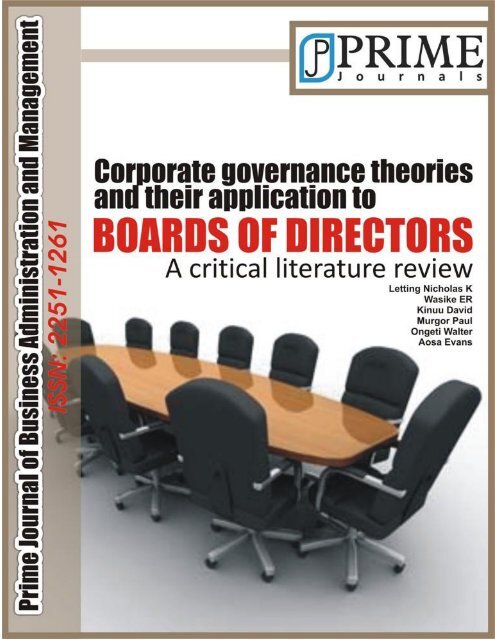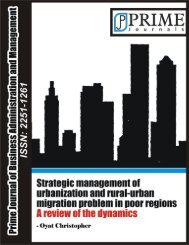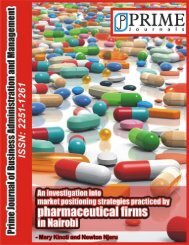Full Article (PDF) - Prime Journals
Full Article (PDF) - Prime Journals
Full Article (PDF) - Prime Journals
You also want an ePaper? Increase the reach of your titles
YUMPU automatically turns print PDFs into web optimized ePapers that Google loves.
*Corresponding Author: nletting@mua.ac.ke, nletting@gmail.com 1 1
<strong>Prime</strong> Journal of Business Administration and Management (BAM)ISSN: 2251-1261. Vol. 2(12), pp. 782-787, December 11 th , 2012www.primejournal.org/BAM© <strong>Prime</strong> <strong>Journals</strong>ReviewCorporate governance theories and their application toboards of directors: A critical literature review1 Letting Nicholas K, 2 Wasike ER, 3 Kinuu David, 3 Murgor Paul, 3 Ongeti Walter, and 4 AosaEvans1 Lecturer, School of Management and Leadership, The Management University of Africa, Nairobi, Kenya.Email: nletting@mua.ac.ke or nletting@gmail.com2 The Director, Nairobi Campus,KabarakUniversity, Nairobi, Kenya3 Doctoral student at the School of Business, University of Nairobi.4 Associate Professor of Strategic Management, School of Business, University of Nairobi and Associate Dean of theSchool.Accepted 12 th November, 2012The ongoing debate on the theories of corporate governance is yet to settle on a specific perspective betweenagency, resource dependence, stakeholders and stewardship theories. While promoters and supporters of eachgroup attempt to rationalize the superiority, and universality of each model in theory, they rarely pay attentionto the long-standing notions, norms and premises underpinning their perspectives which are less credible andvalid in matching the continually changing practice of corporate governance. This paper critically reviews theliterature on corporate governance theories and relates them to the board of directors’ characteristics. In sodoing, it reveals the lack of conventional approaches employed in corporate governance theories. The paperfinally, calls for an integration of all the theories in the field and suggests five areas of future study on corporategovernance in Africa.Key words: Agency theory, corporate governance, board of directors, resource dependence theory, stakeholders’theory, stewardhsip theory.INTRODUCTIONThe current mainstream schools of corporate governancerest their ideas and assumptions on theory of the firmand associated ideologies which were created andconstructed by company law theory and classicaleconomics in the 18th and 19th centuries (Letza et al.,2004). In recent years, the corporate scandals, some ofwhich are still unfolding, involving high incidence ofimproper activities of managers expropriating theresources of a firm at the ultimate expense ofshareholders have prompted the intense re-examinationand scrutiny of some of the existing corporategovernance practices and also considerable interest inempirical research on the effectiveness of variouscorporate governance institutions and mechanisms (Fan,2004).A number of agency problems resulting from theseparation of ownership from control (Berle and Means,1932; Jensen and Meckling, 1976) still prevail in firmsglobally. Nonetheless, agency problems are thenecessary evils of “efficient form of economicorganization” called firms (Fama and Jensen, 1983)where the various resource owners are pooled togetherin order to produce goods or services demanded bycustomers at the lowest cost. Therefore, firms must beconvinced of the importance of grappling with andmanaging corporate governance for their long-termsurvival and growth. This paper attempts to reviewextensively the literature on corporate governance andhow the various corporate governance theories interactwith board of directors charaterisitics to influencecorporate performance.Corporate Governance TheoriesVarious scholars have developed a number of theorieson corporate governance with respect to boards ofdirectors. The scholars have carried out the studies
783 Prim. J. Bus. Admin. Manage.spanning a period of about thirty years. The theoreticalframeworks upon which this review is based are theagency, stakeholder, resource dependence andstewardship theories, which give varied views on thepresence of information asymmetry that the agent (in thiscase, the directors and managers) is likely to pursueinterests that may hurt the principal, or shareholderamong others (Fama and Jensen, 1983). The theoriesform the foundation of the role and effectiveness ofboards of directors in strategic decision-making.The Agency theory is based on the principal-agentframework. Jehnsen and Meckling (1976) viewedorganizations as sets of explicit and implicit contracts withassociated rights. Separation between ownership andcontrol of corporations characterizes the existence ofagency relationship between the board who represent theshareholders and the management who represent theboard and other stakeholders.In the context of corporations and issues of corporatecontrol, agency theory views corporate governancemechanisms especially the board of directors, as beingan essential monitoring device to try to ensure thatproblems that may be brought about by the principalagentrelationships are minimized (Moldoveanu andMartin, 2001; Mallin, 2007). According to Blair (1996),managers as agents must be monitored and institutionalarrangements made to assure checks and balances arein place to avoid abuse of power.Agency theory suggests that boards should consist ofoutside and independent directors. It also proposes thatthe position of the board chairman and chief executiveofficer should be separate (Daily and Dalton, 1992;Balta, 2008). When the separation of those two roles isviolated, mainly when the chairman is under the influenceof the chief executive officer , the agency cost becomesgreat and the firm will suffer in the financial and controlmarket (Dalton et al., 1999; Balta, 2008). AlthoughAgency Theory is the dominant perspective in corporategovernance studies, it has been criticized in recent years(Blair, 1996; Hoskisson et al., 2000; Fan, 2004) becauseof its limited ability to explain sociological andpsychological mechanisms inherent of the principal-agentinteractions (Davis, 1991).The Stakeholder theory takes account of a wider groupof constituents rather than focusing on shareholders(Mallin, 2007). It examines the firm in the context of awider range of implicit and explicit stakeholders havinglegitimate expectations, urgent claims, and/or powerregarding the firm (Jones and Politt, 2002a; Jones andPolitt, 2002b). Stakeholder theorists suggest thatmanagers in organizations have a network ofrelationships to serve that include the suppliers,employees and business partners (Clarkson,1995;Abdullah and Valentine, 2009). This theory focuses onmanagerial or strategic decision-making and suggeststhat the interests of all stakeholders have intrinsic value,and no sets of interests are assumed to dominate others(Clarkson, 1995; Abdullah and Valentine, 2009).According to Stewardship theory, Directors areregarded as the stewards of the company assets and arepre-disposed to act in the best interest of theshareholders (Mallin, 2007). Stewardship theory relatesto the board’s task of providing support and advice tomanagement (Davis, 1991). The stewardship theory hasits roots from psychology and sociology. According toAbdulla and Valentine (2009), stewards are companyexecutives and managers working for the shareholders.The stewards protect and make profits for shareholdersand are satisfied and motivated when organizationalsuccess is attained. Stewardship theory argues that theeffective control held by professional managersempowers them to maximize firm performance andcorporate profits. Regarding the leadership structure,stewards maximise their utility because they achieveorganisational rather than self-serving objectives (Davis,1991; Balta, 2008).Stewardship theorists contend that superior corporateperformance is associated with the majority of insidedirectors because; first, they ensure more effective andefficient decision- making and second, they contribute tomaximise profits for shareholders (Kiel and Nicholson,2003). Consequently, insider-dominated boards arefavoured for their depth of knowledge, access to currentoperating information, technical expertise andcommitment to the firm.Proponents of resource dependency theory haveattempted to explain organisations in terms of theirinterdependence with the environment (Pugh andHickson, 1997, p. 62; Pfeffer and Salancik, 1978). Somescholars have argued that the provision of resourcesenhances organizational functioning, a firm’sperformance and its survival (Daily et al., 2003). Thistheory concentrates on the role of Board of Directors inproviding access to resources needed by the firm(Abdullah and Valentine, 2009). Hillman et al. (2000)contend that resource dependency theory focuses on therole that directors play in providing or securing essentialresources to an organization through their linkages totheir external environment. This theory states thatorganizations are interdependent with their environmentand or other organizations for their survival since they arenot self-dependent (Pugh and Hickson, 1997).The theory thus proposes that corporate board is amechanism for managing external dependencies (Pfefferand Salancik, 1978), reducing environmental uncertainty(Pfeffer, 1972) and environmental interdependency.Resource dependency theory also views outsidedirectors as a critical link to the external environment(Pfeffer and Salancik, 1978). The theory predicts arelationship between the extent of uncertainty anddependence and the composition of the board withrespect to boards’ size and proportion of outside board
Letting et al., 784Table 1: Theories of corporate governanceAgency theory Stewardship Stakeholders Resource dependenceLinks the firm to theUphold interest of allBoard role Control and supervision Service and adviceresources required tostakeholdersmaximize performanceTheoreticalbasisEffectiveBoardsRepresentativestudiesEconomics and financeIndependent (outsider dominatedboard, no social, personal, orprofessional ties between boardand CEO/management)Separate CEO – ChairpersonFama and Jensen, 1983; Hill andSnell, 1988; Baysinger andHoskisson, 1990; Baysinger,Kosnik and Turk, 1991;Source: Adapted from Castro etal., (2009)Sociology andpsychologyInsider dominatedboard. Joint CEO-Chairperson (duality)CEO- board social tiesDonaldson, 1990;Donaldson and Davis,1991,1994; Davis etal.,1997ManagementMaximizing the shareholderreturns is not the soleobjective. Interests of allstakeholders should beequally honouredFreeman ,1984;Donaldson and Preston,1995Organizational theoryand sociologyLarge board Boardmember diversityExternal networksamong board membersand others firms.Pfeffer, 1973; Pfefferand Salancik, 1978;Hillman et al.,2000;members.The foregoing theories of corporate governance thataffect boards of directors roles are summarized in table1.Integration of the theories of corporate governanceHendry and Kiel (2004) explain that the choice of aparticular theoretical perspective depends on contextualfactors such as board power, environmental uncertaintyand information asymmetry. To gain a greaterunderstanding of the board’s role in strategic decisionmaking,there is need to integrate different theories ratherthan consider a single theory alone. All the theoriesassume that the board and management formulatestrategy through a partnership approach (Hendry andKiel, 2004). These perspectives arise from the three mainroles identified by the literature within boards of directors– control, service, and resource dependence (Johnson etal., 1996).Board of directorsBoard of directors as an area of study has generated a lotof interest among researchers (Tricker, 2009). Scholarsand practitioners as well as policy makers have for thelast two decades debated on the role of boards ofdirectors as one of the key pillars of corporateThe composition and demographic characteristics of theboard have been examined in numerous studies as thekey attributes of the board of directors (Westphal, 1999).Board composition subsumes the individual director’spotential to solve the various tasks (Daily etal., 1999) andhas generally been analyzed by examining thedemographic characteristics of the board (Rindova,1999). Board size and board composition have long beenregarded as important components of the governanceprocess for firms in business as it defines the affiliation ofeach director as either inside or outside board member(Lawrence and Stapledon, 1999; Boone et al, 2007;Tricker, 2009).Resource dependency theory suggests that boards withinterlocking directorships are intended to link thecompanies with the external environment and resourcesto maximize their performance (Kiel and Nicholson, 2003;Hendry and Kiel, 2004; Balta, 2008). Some researchersbelieve that interlocking directors serve as a source ofinformation on business (Davis, 1991). The theory ofinterlocking directors suggests that interlocks exist forclass integration and high strategic interdependence oforganizations (Penning, 1981). Researchers have foundcontradictory results regarding the impact of interlockingdirectors on firm performance.Boards of Directors have been known to influence thestrategy of their firms in two main ways: through “decisioncontrol” activities such as evaluating past decisions madeby top management, performing high-level reviews ofstrategic plans, and monitoring executive and firmperformance (Fama and Jensen, 1983) and through“decision management” activities such as ratifyingstrategic proposals, asking probing questions aboutimportant issues, and helping to formulate, assess, anddecide upon strategic alternatives (Judge and Zeithaml,1992). Decision control is the board’s most fundamentalresponsibility, but decision management is nottraditionally considered a necessary board role (Famaand Jensen, 1983). Indeed, the results of past surveys ofgovernance (Mallin, 2007; Tricker, 2009). They haveasserted that boards of directors’ attributes may influencestrategic decision-making and subsequently firmperformance (Cutting and Kouzmin, 2002; Van denBerghe and Baelden, 2005). The increasing interest inthe influence of board of directors’ attributes is becauseof the board’s roles in creating linkages to other resourcedependencies (Balta, 2008; Bathula, 2008). Many studieshave attempted to identify the attributes or mechanismsof the boards of directors that lead to improved strategicdecision-making and corporate performance (Van denBerghe and Baelden, 2005; Barako et al, 2006; Balta,2008; Kajola, 2008; Maharaj, 2009). However, the resultsof these studies have been inconclusive in terms ofdecision-making processes and board involvement. corporate directors affirm that while most boards review*Corresponding Author: nletting@mua.ac.ke, nletting@gmail.com 1 1
785 Prim. J. Bus. Admin. Manage.strategy and executive performance (Harrison, 1987), fewboards play a significant role in strategic decisions(Mace, 1986). However, as relatively few studies havetargeted board strategic involvement, our awareness ofits antecedents and consequences is limited (Finkelsteinand Mooney, 2003).Corporate governance and firm performanceCorporate performance relates to the way and manner inwhich financial resources available to an organization arejudiciously used to achieve the overall corporate objectiveof an organization. Organizations have different ways ofmeasuring their success. The level of success isgenerally based on organizational performance.Moseng and Bredrup (1993) asserted thatorganizational performance is the integration of threebroad dimensions: effectiveness, efficiency andadaptability. The measure of firm performance can beevaluated from the perspective of various stakeholders(Kaplan and Norton, 1992). The various measures ofperformance are either quantitative or qualitative.Quantitative measures include return on investments(ROI), return on assets (ROA) and dividend yield (DY)(Ongore, 2008). Qualitative measures, on the other hand,include market share, employee and customersatisfaction and corporate image or reputation. Firmperformance is therefore a complex and multidimensionalphenomenon in strategic managementliterature (Balta, 2008).Many scholars, such as (Leng, 2004) have sought toestablish whether various corporate governancemechanisms affect corporate performance. Thus far,research on Boards of Directors has been limited in termsof scale and scope and it is considered to be at an earlystage of development (Melyoki, 2005; Kajola, 2008).Abdullah and Page (2009) studied the effect of corporategovernance on corporate performance in the UnitedKingdom’s (UK) 350 listed companies. They found noconsistent relationship between governance structure(board and ownership structure) and companies’ marketbook value.Bathula (2008) suggested that internal governancestructures are substitutable and the firms can chooseappropriate governance options based on what is right forthem. Ongore (2008) conducted a study on the effect ofownership structure, board effectiveness and managerialdiscretion on corporate performance among the listedfirms in Kenya. He concluded that there was nostatistically significant relationship between boardeffectiveness and firm performance. Kajola (2008) in astudy conducted in Nigeria of twenty listed firmsconcluded that there is a positive and significantrelationship between return on equity (ROE) and boardeffectiveness.Numerous studies (Balta, 2008; Kajola, 2008) haverevealed significant association between the Board ofDirectors’ demographic characteristics and strategicdecision-making. According to Pfeffer (1983)demography refers to the composition in terms of basicattributes such as age, educational level, race, length ofservice and social entity. In a study that examined theeffect of corporate governance on the performance offirms in Africa by using both market and accountingbased performance measures Kyereboah-Coleman(2007) found that large and independent boards enhancefirm value and that combining the positions of chiefexecutive officer and board chair has a negative impacton corporate performance. Boards and indeed topmanagers have a critical role in the strategic directionand success of organizations. However, theircharacteristics including age,gender and othercharacteristics coupled with heterogeneity of thecomposition of TMTs will affect organizationalperformance(Kinuu et al., 2012)SUMMARY AND CONCLUSIONSCorporate governance issues have gained worldwideattention in the last decade with the spectacular collapseof Enron, when the boards of directors of many underperformingfirms were reluctantly thrust into the spotlight(Tricker, 2009). In this paper, we have reviewed therelevant theoretical and empirical literature on coporategovernance and related them to board of directors’ andcorporate performance. The theoretical perspectives ofcorporate governance in general and boards in particularsuch as agency, resource dependence, stakeholder andstewardhip theories were critically reviewed.The literature on corporate governance examines theefficacy of firm performance and relates it to boards ofdirectors and various other governance structures. Whilethere is increasing evidence of the failure of certaingovernance structures to control and motivate managersto increase firm performance, the empirical evidence todate is mixed and gives little coherent evidence for theshape of an optimal governance structure. Oneexplanation is that existing theories have not beensufficiently complete to include all major determinants ofgood corporate governance. Perhaps there will never beone optimal governance structure because there aredifferences between two firms, markets, legal regimes orcultures, resulting in highly complex issue of corporategovernance. Ultimately governance structure isdetermined by a combination of the foregoing issues andtheir dynamics.A more likely and useful outcome of the on-goingdebate and research, may be the increasing focus onshareholder interest and concerns, and identification ofsome widely accepted guiding principles, rather thantrying to find some specific mechanisms which areuniversally applicable, for effective corporate governance.Each organization remains unique in its structure,product,ownership and so governamce issues will continue being
Letting et al., 786as diverse as organizations are. Structuring organizationsand indeed applicability of the theories in designing andcomposing boards will therefore be dependent on theunique position of the firm.Suggestions for future researchGenerally, there is excessively large amount of researchamong developed countries such as the Europe, Americaand Asia. Given corporate governance concerns humanbehaviors and business practices, and the differentimpact of different institutional environments and cultureon corporate governance, there is an urgent need forworkable corporate governance model for Africa. In thecontext of Africa, some areas are worth being furtherresearched into: -- How unique institutional environments in Africa wherebyhigh shareholders and government ownership, weaklegal investor protection and lack of active market forcorporate control exist have affected corporategovernance structures such as board characteristics; andexplore alternative models where the roles of foreigninstitutional investors, fund managers, firm reputation,proxy contest and other voluntary mechanisms may beemphasized.- There are successful family owned or controlledcompanies in Africa. More in-depth empirical study on themerits and demerits of family ownership structure andhow has it impacted firm value. May be the resourcedependency theory can better explain the success ofthese companies. If so, how corporate governance mayevolve in these companies and what can be done tobetter align the interest of controlling family ownership,continuity in family owned businesses and othershareholders.- Despite the presumed importance of the directordemographic characteristics and board composition asboard attributes, very little rigorous research hasexamined the extent to which independent and outsideboard members actually monitor and advise topmanagement team (TMT) in strategic decision makingprocesses (Tricker, 2009).- The degree to which board independence or multipleappointments play a role in monitoring and advising themanagement team towards sustainable corporateperformance requires examination (Carpenter andWestphal, 1999).REFERENCESAbdullah A, Page, M. (2009).Corporate Governance andCorporate Performance: UK FTSE 350 Companies,Published by The Institute of Chartered Accountantsof Scotland CA House, 21 Haymarket YardsEdinburgh EH12 5BH.Abdullah H, Valentine B (2009).Fundamentals and EthicsTheories of Corporate Governance.Middle EasternFinance and Economics, 4: 88-96.Balta ME (2008). The Impact of Business Environmentand Boards of Directors on Strategic Decision –Making: A Case Study of Greek Listed Companies,Unpublished PhD Thesis, Brunei Business School.Barako DG, Hancock P, Izan HY (2006).Relationshipbetween Corporate Governance Attributes andVoluntary Disclosures in Annual Reports: The KenyanExperience.Financial Reporting, Regulation andGovernance 5 (1).Bathula H (2008). Board Characteristics and FirmPerformance: Evidence from New Zealand .Unpublished Doctor of Philosophy (PhD) thesissubmitted to Auckland University of Technology, NewZealand.Baysinger BD, Hoskisson RE (1990). The Composition ofBoards of Directors and Strategic Controls: Effects onCorporate Strategy. Aca. Manage. Rev., 15: 72-81.Berle AA, Means GC (1932). The Modern Corporationand Private Property,Macmillan, New York.Blair M (1996).Ownership and Control: RethinkingCorporate Governance for the Twenty-first Century,Brookings Institution, Washington.Boone AL, Field LC, Karpoff JM, Raheja CG (2007). TheDeterminants of Corporate Board Size andComposition: An Empirical Analysis. J. Finan. Econs.,85(1): 66–101.Castro CB, De La Concha MD, Gravel JV, Periñan MMV(2009). Does the Team Leverage the Board’sDecisions? Corporate Governance: An InternationalReview, 17(6): 744-761.Carpenter MA, Westphal JD (1999). A NetworkPerspective on How outside Directors ImpactStrategic Decision-Making based on The SocialNetwork Ties: Examining the Impact of DirectorAppointment on Board involvement in StrategicDecision-Making. Aca. Manage J., pp. 1-27.Clarkson M (1995). A stakeholder framework foranalyzing and evaluating corporate performance, Aca.Manage. Rev., 20(1): 92-117.Cutting B, Kouzmin A (2002). Evaluating CorporateBoard Cultures and Decision-Making. J. Corp.Govern., 2(2): 27-45.Daily CM, Dalton DR (1992). The Relationship betweenGovernance Structure and Corporate Performance inEntrepreneurial Firms.Journal of Business Venturing,Vol. 7, No.5. pp. 375-386.Daily CM, Dalton DR, Canella AA (2003). CorporateGovernance: Decades of Dialogue and Data, Aca.Manage. Rev. 28(3): 371-383.Dalton DR, Daily CM, Johnson L, Ellstrand A (1999).Number of Directors and Financial Performance: AMeta-Analysis. Aca. Manage. J., 42:. 674-686.Davis JH (1991). Board Leadership Roles andShareholder Returns: An Examination ofAgency,Doctoral Dissertation, The University of Iowa.Fama E, Jensen M (1983). Separation of Ownership
787 Prim. J. Bus. Admin. Manage.and Control, J. Law Econs, 26(12): 301-325.Fan PS (2004). Review of Literature and EmpiricalResearch on Corporate Governance By FinancialServices Group Training Unit Monetary Authority ofSingapore. Monetary Authority of Singapore (MAS)Staff PaperFinkelstein S, Mooney A (2003). Not The UsualSuspects: How to Use Board Process to Make BetterBoards, Academy of Management Executive, 17(2):101-113.Freeman RE (1984). Strategic Management: AStakeholder Approach, Marshfield, MA: Pitman. p.6.Harrison JR (1987). The Strategic Use of CorporateBoard Committees.California Management Review,30(1): 109-125.Hendry K, Kiel GC (2004). The Role of the Board in FirmStrategy: Integrating Agency and OrganizationalControl Perspectives. Corporate Governance: AnInter. Rev., 12(4): 500–520.Hillman A, Canella A, Paetzold R (2000). The ResourceDependence Role of Corporate Directors: StrategicAdaptation of Board Composition in Response toEnvironmental Change, J. Manage. Stud., 37(2): 235-255.Hoskisson RE, Eden L, Lau CM, Wright M (2000).'Strategy in Emerging Economies', Aca. Manage. J.,43(3): 249-267.Jensen MC, Meckling WH (1976). Theory of the Firm:Managerial Behaviour, Agency Costs and OwnershipStructure, J. Finan. Econs., 3(4): 305-360.Jones IW, Pollitt MG (2002a). Who InfluencesDebates inBusiness Ethics? An Investigationinto theDevelopment of Corporate Governance in the UKsince 1990. In I. W. Jones and M. G. Pollitt (eds),Understanding How Issues in Business EthicsDevelop. Basingstoke: Palgrave.Jones IW, Pollitt MG (2002b). Understanding How Issuesin Business Ethics Develop: Lessons for Business. InI. W. Jones and M. G.Pollitt (eds), Understanding HowIssues in BusinessEthics Develop. Basingstoke:Palgrave.Johnson JL, Daily CM, Ellstrand AE (1996).Boards ofDirectors:A review and research agenda. J. Manage.22: 409-438Judge WQ, Zeithaml CP (1992). Institutional andStrategic Choices on Board Involvement in StrategicDecision Process. The Aca. Manage. J. 35(4): 766-794.Kajola SO (2008). Corporate Governance and FirmPerformance: The Case of Nigerian Listed Firms.Euro. J. Econs, Finan. Admin. Sci, 14: 16-28.Kaplan RS, Norton D (1992). The Balanced Scorecard-Measures that drive performance. Harvard BusinessReview, 1/2: 71-79Kiel G, Nicholson G (2003). Board Composition andCorporate Performance: How the Australianexperience informs contrasting theories of corporategovernance. Corporate Governance: An InternationalReview, 11(3): 189–205.Kyereboah-Coleman A (2007). Corporate GovernanceAnd Firm Performance In Africa: A Dynamic PanelData Analysis, A Paper Prepared for the “InternationalConference on Corporate Governance in EmergingMarkets”Lawrence J, Stapledon G (1999). Is Board CompositionImportant?A Study of Listed Australian Companies,Manuscript.Leng A (2004). The Impact of Corporate GovernancePractices on Firms’ Financial Performance: Evidencefrom Malaysian Companies, ASEAN EconomicBulletin, Vol. 21, Vol. 3, pp. 308-318.Letza S, Sun X, Kirkbride J (2004). Shareholding VersusStakeholding: a critical review of corporategovernance. Corporate Governance, 12(3): 242 – 262.Mace ML (1986). Directors: Myth and Reality, HarvardBusiness School Press, Boston, MA.Maharaj R (2009). View from the Top: What Directors Sayabout Board Process. J. Corp. Govern., 9(9): 326-338.Mallin CA (2007). Corporate Governance. Second Edition,Oxford University Press.Melyoki LL (2005). Determinants of Effective CorporateGovernance in Tanzania, Published PhD dissertation ofthe University Of Twente, The Netherlands.Moldoveanu M, Martin R (2001).Agency Theory and theDesign of Efficient Governance Mechanisms.RotmanSchool of Management, University of Toronto.Moseng,B. and Bredrup H.(1993). A methodology forindursrtial studies of productivity performance .Production Planning and Control,4(3),198-206.Ongore VO (2008). The Effects of Ownership Structure,Board Effectiveness andManagerial Discretion onPerformance of Listed Companies in Kenya, UnpublishedPhD Thesis, University of Nairobi, Kenya.Pfeffer J (1972). Size and Composition of Corporate Boardsof Directors: The Organization and its Environment,Administrative Science Quarterly, 17(2): 218-228.Pfeffer J, Salancik GR (1978).The External Controlof Organizations: A Resource DependencePerspective.New York; Harper and Row.Pugh DS, Hickson DJ (1997).Writers on Organizations.Thousand Oaks: Sage Publications, Inc.Rindova VP (1999). What Corporate Boards Have To DoWith Strategy: A Cognitive Perspective. J. Manage.Stud., 36(7): 953–975.Tricker B (2009).Corporate Governance: Principles, Policiesand Practices, Oxford University Press.Van den Berghe LAA, Baelden T (2005). The ComplexRelation between Director Independence and BoardEffectiveness. J. Corp. Govern., 5(5): 58-83.Westphal JD (1999). Collaboration in the Boardroom:Behavioral and Performance Consequences of CEO-Board Social Ties. Academy of Management Journal,Vol. 42, pp. 7-25.





![See Full Article [pdf] - prime journals limited](https://img.yumpu.com/49292987/1/190x245/see-full-article-pdf-prime-journals-limited.jpg?quality=85)



![See Full Article [pdf] - Prime Journals](https://img.yumpu.com/44526114/1/190x245/see-full-article-pdf-prime-journals.jpg?quality=85)


![See Full Article [pdf] - prime journals limited](https://img.yumpu.com/42270022/1/190x245/see-full-article-pdf-prime-journals-limited.jpg?quality=85)

![See Full Article [pdf] - Prime Journals](https://img.yumpu.com/41607332/1/190x245/see-full-article-pdf-prime-journals.jpg?quality=85)
![See Full Article [pdf] - Prime Journals](https://img.yumpu.com/41231982/1/190x245/see-full-article-pdf-prime-journals.jpg?quality=85)
